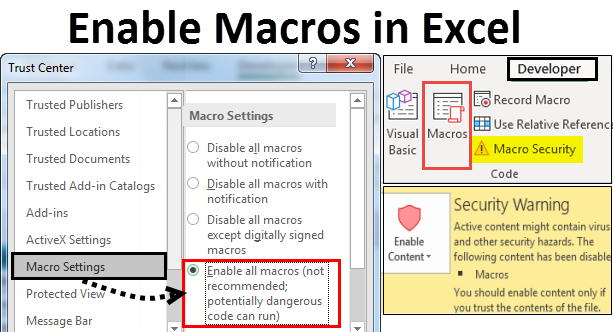Excel Enable Macros is a website that provides macros for Excel. Detailed instructions are provided on how to enable macros in Excel, as well as tips on how to use macros effectively. For your own projects, we also offer a wide range of macro-enabled Excel templates.
Introduction:
Ensure that macros are enabled in Excel if they are disabled. In recent Office updates, many people have found that their macros have been disabled when using Excel at work.
The ‘Trust Center Settings’ button is greyed out when they choose the ‘File’ tab, select ‘Options’, and then select the ‘Trust Center’ tab.
It is also possible that the ‘Macro Settings’ button has also been disabled. The purpose of this blog is to demonstrate how to reactivate macros that have been disabled in Excel.
What are Macros?
Users can automate tasks using macros, which are a type of programming. The macros are written in a special language, which is interpreted by a macro processor. It is common for applications or programming languages to include macro processors.
A macro can be used to automate repetitive tasks or to add new functionality. A macro can be used to fill out a form automatically, for example. Additionally, macros can be used to create new commands and functions.
Macro scripts can be written in any programming language, but they are usually written in the language of the application or programming language in which they are intended to be used.
What is an excel macro?
The purpose of an Excel macro is to automate repetitive tasks by recording a series of actions and then playing them back. In Excel, macros are written using Visual Basic for Applications (VBA), a programming language.
Excel stores macros as VBA modules in the current workbook when you record them. Using the macro, you can automate tasks by naming and describing them.
How to enable macros?
To enable macros in your word-processing software, you must follow a few simple steps. To begin, open the software and locate the “Preferences” or “Options” menu. In this section, you should find an option to enable macros under the heading “Security” or “Privacy.”
By clicking this option, you will be able to enable macros. The software should now be able to use macros once you have saved the changes.
How to use excel macros?
Using Excel macros can be a very useful tool for automating tasks.
Step: 1
The first step in using a macro is to record it. Open the workbook in which you would like to record the macro and click the “Record Macro” button on the “Developer” tab.
Step: 2
You will then be able to specify the name and shortcut key for the macro in the “Record Macro” dialogue box. You can then perform the actions in Excel that you wish to record. The “Stop Recording” button should be pressed once you have completed the recording.
Step: 3
As soon as you have recorded a macro, you can replay it by pressing the shortcut key you specified, or by selecting it from the “Macros” dialogue box. By pressing the “Edit Macro” button, you can also modify the macro code. As a result, you will be able to make changes to the code using the Visual Basic Editor.
How to create a macro?
In computing, a macro is defined as a set of instructions that can be executed repeatedly and automatically. It is possible to create macros either by using a macro recorder or by editing a macro file.
By using a macro recorder, you can record the steps you take to complete a task. You can replay the macro to automatically complete the task once you have recorded your steps.
An editor such as Notepad can be used to create a macro by editing a macro file. Using the text editor, you can add the desired instructions to the macro file. As soon as you have finished adding instructions, save the file and close the text editor.
Where can you use macros?
The use of macros can be beneficial in a variety of situations for automating tasks and saving time. It is possible to insert boilerplate text, format text or images, or perform calculations using macros, for example.
It is also possible to use macros to control applications, for example, to open a web browser or an email client. The use of macros is generally applicable anywhere repetitive tasks must be performed.
Why should you use macros?
It is possible to streamline repetitive tasks in Excel by using macros. Creating a macro allows you to record your steps once and replay them as often as you need, with just a few clicks. You will be able to save a great deal of time if you have to perform the same steps regularly.
Furthermore, macros can be used to automate complex tasks that would be difficult or impossible to perform manually. An example would be using a macro to generate a report automatically based on a large amount of data.
As a whole, macros can save you a significant amount of time and effort, and they can enable you to accomplish tasks that would otherwise be impossible or difficult. You should consider using a macro if you find yourself performing the same steps in Excel over and over again, or if you need to automate a complex process.
Conclusion:
Macros are a useful tool you can use in Excel to automate a certain task. Macros are also known as Visual Basic for Applications. Macros can be used to speed up repetitive tasks and allow you to enter that data straight into a spreadsheet.







